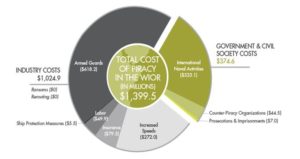Piracy in the Gulf of Aden and Indian Ocean started in 2005 by Somalia parities and reached its climax in 2011 when they have attempted to hijack 237 vessels and at year’s end, seized 11 vessels, keeping a total of 216 people as hostages. At the time parities used to make on average 2 million dollars for every ship seized and ransomed.
Oceans beyond piracy (OBP) estimated the total 2015 costs related to Somalia piracy to be $1.4 Billion. A lion share of this cost was appropriated for anti piracy activities including deployment of warships and recruiting of private security army personnel aboard on ships.

Source: Oceans beyond piracy (0BP).
As reported by Aljazeera in 15 March 2017 –“A volatile build –up of weapons and resentment along the northern Somali coast of (Punt land) culminated in the hijack of an oil freighter this week, the first such seizure by Somali pirates since 2012, experts and locals say”. Aljazeera further reports on the cause of piracy resurfacing on the coast of Somalia-“The lull encouraged foreign fishing vessels to return to Somali waters, locals told Reuters news agency, fuelling resentment.”If you look at the sea at night, there are so many lights outs there [from fishing vessels]. It looks like New York,” complained one former Somali official who asked not to be named.
A volatile build-up of weapons and resentment along the northern Somali coast culminated in the hijack of an oil freighter this week, the first such seizure by Somali pirates since 2012, experts and locals say.
Gunmen hijacked the Aris 13, a small oil tanker, on Monday and are demanding a ransom to release the ship and its eight Sri Lankan crew, the European Union Naval Force that patrols the waters off Somalia said on Wednesday. The final straw, he said, was when seven Thai fishing vessels docked at Bosaso port last month. The ships paid the local government more than $672,000 for fishing licenses, a government contract showed. The move infuriated locals who felt they would see neither fish nor the cash.”
The main causes of piracy resurfacing are illegal fishing, corrupt authorities, rural economic deprivation due to drought and the dumping of waste on the sea. As long as such factors exist attempts to hijack ships will continue, since the solution does not lie onshore but offshore by removing the real causes of piracy on the ground.
The Republic of Somaliland with its coast on the Gulf of Aden kept away piracy on its coast. However corrupted politicians, economic inequality, unemployemnt, recurrent ardent drought and various other grievances may force youth to resort undesirable ends such as piracy.
Therefore,Paricy in the Gulf of Aden and the Indian ocean could not be uprooted on mounting armed personnel on ships but it could removed by solving the real causes on the ground which is economic deprivation, bad governance, corruption (fishing licenses),and ardent recurrent drought.
By:Mohammed Dahir Ahmed
Hargeisa,Somaliland































